Halloween Events Around Ann Arbor
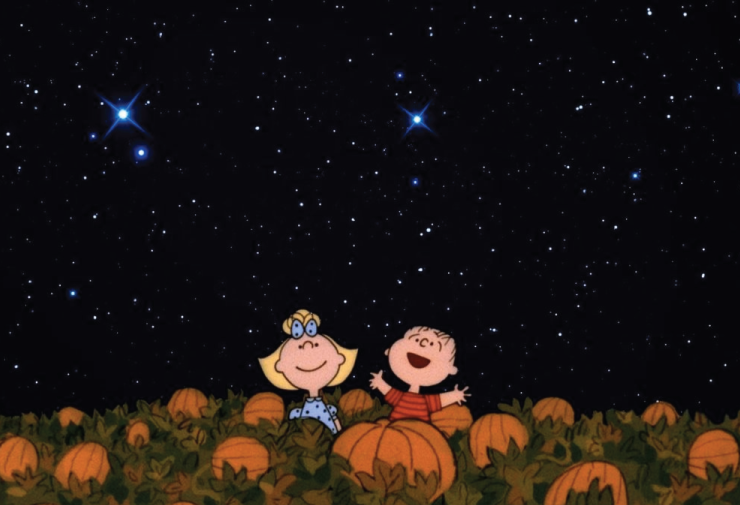
If you're looking for some fun events around town for the Halloween weekend, read on for creepy cemetery tours, devilish dance parties, shadow puppet theatre, and more Halloween arts & culture:
Book-Themed Halloween Costume Contest
Monday, October 31st - 10:00am-9:00pm
Literati Bookstore - Ann Arbor, MI
Halloween at the Market
Saturday, October 29th - 12:00pm-2:00pm
Ann Arbor Farmer's Market - Ann Arbor, MI
Highland Cemetery Lantern Tours
Sunday, October 30th - 7:00pm-9:00pm
Highland Cemetery - Ypsilanti, MI
Shadow Puppet Double Feature
Saturday, October 29th - 9:00pm-11:00pm
Triple Goddess Tasting Room - Ypsilanti, MI
Cultivate Masquerade & Costume Bash
Friday, October 28th - 8:00pm-12:00am
Cultivate Coffee & Taphouse - Ypsilanti, MI
Black Cat Cabaret - Neighborhood Theatre Group
Friday, October 28th and Saturday, October 29th - 8:30pm
Bona Sera - Ypsilanti, MI
Halloween Treat Parade
Monday, October 31st - 11:00am-5:00pm
Main Street Area - Ann Arbor, MI
A2DC Presents: Hullabaloo Halloween Spooktacular
Sunday, October 30th - 6:00pm-10:00pm
Ann Arbor Distilling Company - Ann Arbor, MI
The Bang! Halloween Dance Party
Saturday, October 29th - 9:30pm
The Blind Pig - Ann Arbor, MI
Nightlife Arcade Gaming Spooktacular
Friday, October 28th - 6:00pm-9:00pm
The Forge by Pillar - Ann Arbor, MI
Preview: The Ypsilanti Heritage Festival Returns for its 38th Year!

The tents are going up, the buzz is in the air, and it’s easy to tell that a long-running local celebration is back for another year! This weekend the annual Ypsilanti Heritage Festival returns to Riverside Park with live music, entertainment, food, vendors, and countless other activities. This year marks the 38th annual celebration of this community festival, which started as the Ypsilanti Yesteryear Heritage Festival back in 1978 and has been honoring the city of Ypsi, its quirky culture, and its rich history every year since.
Highlights for this year include a community food tent, a magic show, a rubber ducky race, bounce houses, a touch-a-truck event, free access to many of Ypsi’s local historical buildings and museums, and a presentation by local historian Matt Seigfried on the incredible tale of local legend HP Jacobs. This year also features the triumphant return of Noise Permit, a musical event showcasing Ypsi’s talented teens in Frog Island Park.
The festival will once again sprawl between Riverside Park, Frog Island Park, and Depot Town. Entry to the festival and many of its events are free, but some events will require tickets or payment. If you’re the plan-ahead type, a full schedule of the Ypsilanti Heritage Festival’s events can be found on their website.
The Parkridge Summer Festival and DIYpsi craft fair will both take place over the next couple of days as well, so there will be no shortage of noise, fun, and sights to see in Ypsi this weekend!
The Ypsilanti Heritage Festival will take place on August 26, 27, and 28, 2016. For more information and a full schedule of events, visit YHF's website.
North Washington Street Porch Shows

In a town as rich in creative energy as Ypsilanti, musical performances can happen pretty much anywhere, and the Washington Street porch shows are proof. The spacious porch of 201 N. Washington Street in Ypsi has become the perfect DIY venue for local musical talent and casual community gatherings, put together almost entirely by Washington Street resident J.T. Garfield.
The magic of these shows comes from their completely laid-back, free-form atmosphere. Usually artists perform from the porch while the audience relaxes on folding chairs or plunks down right on the lawn. And if the musician doesn’t feel like playing up on the porch, well, he or she might just sit in the grass too and play from there. During one rainy Sunday show, Washington Street residents threw together a covering that was part zip-tie, part tarp-fort, part tent to cover the entire porch and the audience. Even the line-up is changeable, with some improvisational music acts jumping up on stage as the spirit moves them.
While the shows’ schedules are often packed with local musicians, there is always an effort to keep things interesting by including comedians, dancers, spoken word artists, and other diverse types of performance art. Past acts include Matt Jones, Misty Lyn, Fred Thomas, and J.T. himself, who belongs to the band Truman.
There’s no real schedule for these shows, but that’s no surprise when everything about this event speaks to its easygoing, yard-barbecue atmosphere. As of now, there’s only one future porch show with a date, on September 4th, so if you happen to be just cruising down Washington around 6pm and in the mood for music, it’ll be your lucky day.
For an excellent interview with J.T. Garfield on the origins and vision of the porch shows, check out this article from Ypsi Real by Michael Moriarty.
The next Washington Street porch show will be on September 4th at 6pm outside 201 N. Washington St. This free event is open to the public.
Pulp Staffers' 2016 Art Fair Picks
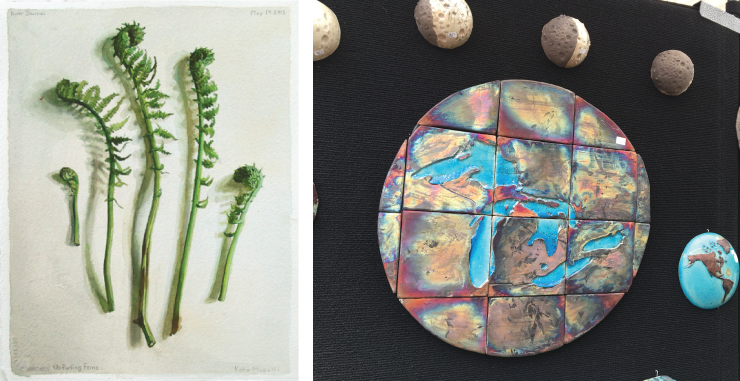
Have you guys ever noticed that Art Fair is HUGE? Or that it's unbearably hot (not just this year, but somehow every year)? It can make it pretty difficult to hit all of the thousands of booths that are set up to find the best of the best. This year, Pulp staffers decided to help by heading out on opening day and finding our favorites. These artists are all definitely worth checking out, whether you are looking to buy or looking to look.
Stan H. Baker
Stan H. Baker, ceramic artist from Ann Arbor, was set up on Main Street selling his map plates and wall globes. The wonderful details of the wall-mounted half moons caught my attention – each one depicts a different phase of the moon. What drew me in further was when I realized that he is masterfully using the raku firing technique for the purpose of depicting the dark portion of the moon. He is also able to get beautiful iridescent glaze effects. I’m a big fan of maps and his didn’t disappoint. -Anne
Jen Callahan, Coastal Colors
Jen Callahan is a Florida-based artist whose artwork looks like a paint-aisle explosion in the best way possible. Her artwork features beachy, seaside settings and underwater creatures, made all the more enchanting by her vibrant color palette that seems to include everything from tranquil blues and purples to luminous greens and pinks. If you've never seen a rainbow-coated jellyfish or a sea turtle painted like a stained-glass window, it's definitely time to upgrade your life. -Nicole
D & M Wooden Flowers
D & M is local, based out of Saline, and their brilliantly-colored wooden flowers are some of the most impressive wood carvings I have ever seen. Their basswood lilies, tulips, and daffodils are painted in sunny colors that render them bright, detailed, and so realistic that I almost can't remember why I bother to buy real flowers when I could be buying breathtaking wooden daises that my cats can't destroy and eat. -Nicole
ISMS - Holly Ulm
Minnesota-native Holly Ulm drew my eye through the natural colors of her incredibly delicate-looking butterfly jewelry and art prints. Her art is offbeat and whimsical, featuring things like a black and white cat with brightly-colored Monarch wings or a mermaid with a tail that changes smoothly into the wings of a moth. All of Ulm's art uses the wings of real butterflies who have completed their life cycles and died of natural causes at butterfly conservation farms. Ulm then uses what I can only imagine is a 100-bajillion-step process to preserve the wings in as close to their natural state as possible--and she does a beautiful job. Each piece of jewelry is gorgeous and every art print manages to incorporate the wings in a way that lets their natural beauty speak for itself. -Nicole
Katydids Kritters
Katydids Kritters is another local artist who makes art of the 3-dimensional variety. Her adorable hand-sewn wares are not only decorative, but functional! Owl-shaped doorstops, little critter sleep masks, and hot and cold therapy plushies that can be used on sore muscles and other pains. Because how could you possible still feel bad with an adorable stuffed penguin hanging out on your sore knee? You can't, that's how. -Nicole
Katie Musolff
When looking through booths I might take a closer look at before going out (you've got to make a plan on these 95 degree days), Katie Musolff's work didn't make my list. Interesting photographs, but that's not really my thing. But this is because thumbnails don't do her work justice. Those plants and animals, all apparently photographed from above in museum cases or on kitchen tables, aren't photographs at all but exquisitely rendered gouache paintings. They are done with such skill that they appear at a distance to be the real thing, but this is not photorealism or trompe-l'oeil. Musolff has simply mastered her tools so well that her paintings communicate all the essence and form of her natural subjects. Mushrooms pop off the page and fiddlehead ferns are in their brightest April green. Musolff conveys the life of these items, freshly ripped out of the ground for their moment of immortality. As you look, you can almost smell them.
-Andrew
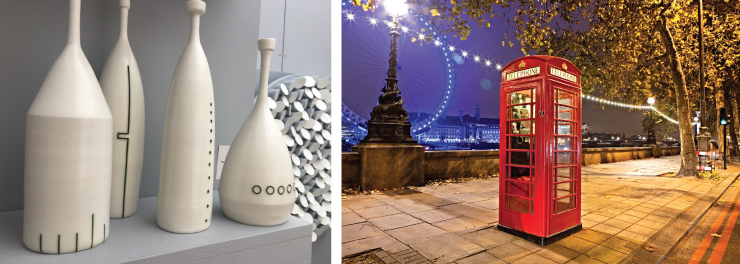
Michelina Risbeck
Michelina Risbeck is a University of Michigan student. She creates mixed media works using household paint and joint compound on Plexiglass that explore the interplay of texture and color. Often reminding me of landscapes or abstract renditions of microscopic biological processes--like the division of cells--or the chaos that was the beginning of the universe. One of the artists I was totally blown away by in the Street Art Fair's New Art, New Artists (NANA) booth, selected to participate in this one-on-one mentoring program and are exhibiting for the first time at the Art Fair.-Anne
Chris Rom & Geoff Buddie
Ohio husband and wife team Chris Rom and Geoff Buddie are back for their ninth Ann Arbor Art Fair. Their work is a collaborative effort; they use porcelain, wood, fiber, and mixed media to create elegant minimalistic works. Repetition of shape creates visual interest and the hint of sequence. Their work ranges from familiar objects, such as bottles made of porcelain with a clear glaze and minimal black line decoration, to larger more abstract wall installations made up of repeating geometric 3D shapes. Intricate shadows add to the overall composition, which changes with the angle of light or the viewer’s angle of perspective. There is an order to their work that evokes a sense of calm. Though neither Chris nor Geoff would admit to an overtly mathematical background, they did mention that there is at least one engineer in their family. An earlier work of theirs is on permanent display at the Downtown Library (first floor near the new books). -Anne
Christine Schub
Christine Schub has been showing at the Street Art Fair for about 20 years now, and there's a reason why she is a staple. Her work never disappoints in its intricacy and liveliness. Strictly nonrepresentational, her paintings lead the viewer to imprint their own loves on them; I see city buses, building facades, aerial views of landscapes, and geological layers, all dancing around each other. She says that hearing what people see is one of the most enjoyable parts of being a painter and coming to the Fair. There are certainly echoes of Mondrian before he went full-on neoplasticist, but you won't find any rigidly straight lines here. These paintings almost appear ready to drip right off the canvas, and it's that life and presence that has made Schub's work worth checking out all of these years. -Andrew
Kyle Spears
I was drawn to the red phone box sitting like a Tardis at the center of Kyle Spears’ “London, England” color photograph. A string of white lights runs behind it and down the receding sidewalk, while further beyond lies the London Eye and the Houses of Parliament lit in bright blue. Other prints in Spears’s booth are similarly alive with color, light, and contrasting edges or textures, an effect enhanced through long exposure using a medium format film camera and a combination of traditional and digital printing techniques. A couple black and white photographs focus on what Spears calls “moments of beauty amid chaos”: In “Notions of Time, Paris, France,” an odd-shaped corner building and striped crosswalk precede a curved alley and a ghostly time-lapsed figure; in “Fragile, Tokyo, Japan,” a jumble of squares, rectangles, and lines define the back of a building complex while simultaneously framing a woman’s face on a billboard. Spears not only shows us the world we see, he shows us the world as we’d want to see it. -Amy
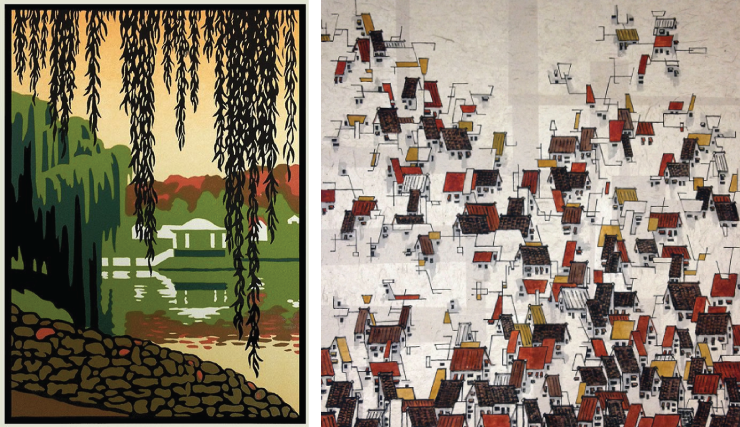 Impermanence #713 by Nha Vuu.">
Impermanence #713 by Nha Vuu.">
Nha Vuu
Nha Vuu had a few different things on offer, including some beautiful, large-scale renderings of flowers and other plants that evoke traditional Chinese paintings, but the things that drew me in were the rooftops. Vuu has a number of large works that depict the roofs of crowded residential areas, just lines of ink applied with a brush that hint at actual structures, occasionally with a splash of color, all on handmade paper. These remind one a bit of those same traditional Chinese paintings, but also of Cezanne's Provencal landscapes, Russian Constructivism, and Richard Thompson's Cul de Sac. In the smaller works, the rooftops dissolve into unrecognizable abstractions, easy to take as being not at all representational, simply a pleasing arrangement of lines and shapes. Each of the works shows a mastery of composition, whitespace, and the daringness to eschew all but a very limited palette, used in a very limited way. The alleys and backstreets between these houses are ones you'll want to explore up close. -Andrew
Christopher Wheeler
The best art is almost never the same piece at two feet away that it was at twenty. Christopher Wheeler's mixed media pieces fit this bill very nicely, changing as you approach, inviting you to come in closer, and then requiring that you back up again to take it all in. As you pass by the booth, his large pieces seem to just be paintings: flattened, geometric representations of trees and building facades. Lovely, but sterile in a midcentury modern sort of a way. But upon closer inspection, you find that those flattened shapes are not flat at all but made up of small pieces of paper, painted and then applied to make up a color area with subtle texture. Each of the birch limbs is a Matisse-like cutout, lightly painted in a way that, as you back up, makes you marvel that four cuts with scissors and one pass with a brush can give such a perfect illusion. It all combines to create works that draw you in to inspect, then pull back out to look at the whole again, then zoom in on another aspect. If you buy one, be sure to place it where people can look at it up close and where the light can show off those beautiful textural variations.
-Andrew
Jack White
Retired engineer Jack White’s photography is sharp and full of wonderful contrasts. Though he’s from Pinckney, MI, his Rocks and Roots series was shot in New England. Tree roots and granite form a symbiotic relationship as they become entangled over time. Jack has an eye for framing the perfect shot and capturing just the right moment when the light hits it just so. Most of his photographs are black and white, but if you look closely you’ll catch a hint of color (added by hand) in some. Another of the artists I was totally blown away by in the Street Art Fair's New Art, New Artists (NANA) booth-Anne
Laura Wilder
I'm a sucker for block printing so as I was exploring the S. University Fair I was drawn to Laura Wilder's booth immediately. The intensity of the colors, contrast, and the use of negative space are magnetic in block printing. Wilder's work pulls you in and a close inspection is required. I was drawn initially to her depictions of nature, seasons, ferns, and other flora. I particularly liked her block print entitled Hiawatha Lake because she uses the willow trees to softly frame the structure in the background. Once in her booth I was equally drawn to her whimsical and lovely serigraph, The Scottie, just one of her many dog breed pieces. Wilder's Seasons IV, a four-season woods/stream framed piece would make a dramatic and soothing addition to a room. The panoramic layout, the use of color and the intensity of the work evoke the movement and shadows in nature. My favorite pieces were traditional block prints. Wilder describes the process: usually created with wood or linoleum blocks; non-image area is cut away, leaving only the image surface raised above non-printing areas. The ink is usually applied with rollers; may be printed with a press, a baren, a rolling pin, or a wooden spoon. Wilder offered her work in lush wood frames as well as limited edition giclees, note cards, mini-prints, posters, and more. Wilder is from Rochester, NY, and some of her work is off landmarks and popular spots in that region. -Erin
Nick Wroblewski
Printmaker Nick Wroblewski’s woodblock prints are breathtaking. Obviously he is inspired by the Japanese woodblock tradition, but his subjects and colors are unmistakably North American. Beautiful forest scenes, wetlands, and birds are all masterfully recreated. He uses the reduction printing method where a multi-color print is created using only one block by cutting away more and more of the surface in-between each color printing. The block is ultimately destroyed as each new color is carved. He has an example of the carved blocks on display to illustrate the process. Definitely worth a look. -Anne
Pulp staffers declined to write about their real Art Fair Picks: water bottles, t-shirts, umbrellas, and shady trees.
The 2016 Ann Arbor Art Fair will continue through Sunday, July 24, 2016.
AAFF Wrap-Up: Dispatches From A First-Timer
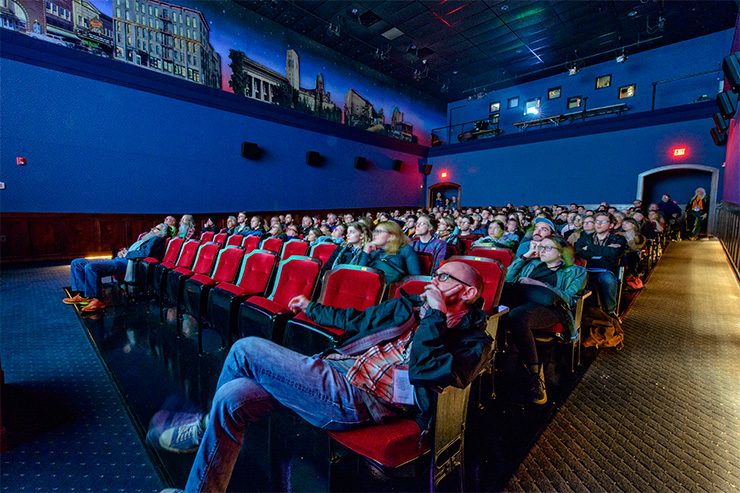
The Ann Arbor Film Festival has been a staple of the Ann Arbor arts scene for over half a century. Every year films from around the world are submitted, judged, and shown to hundreds of movie-lovers, and every year I think to myself, “Eh. Maybe I’ll go some other year.”
This year my curiosity finally outweighed my love of staying home and I found myself preparing to attend the 54th Ann Arbor Film Festival.
It’s important to note that I’m an avid movie-goer. I can sit through the goofiest horror movies, the most pointless action movies, and the sappiest romantic comedies, because I just love being at the movies. I like pulling up to the theater on a sunny day and people-watching as I’m waiting in line to buy my ticket. I like sitting in the dark, reading the screen trivia, and waiting for my movie to start. I like theater pretzels and, more importantly, the strange, delicious, scientific mystery that is theater cheese.
My unbelievably low movie standards don’t hurt either. I mean, I liked ALL of those Transformers movies.
But despite my wide-ranging love of cinema, I worried about attending something as serious and prestigious as the AAFF. I worried that it would be dull. I worried that it would full of be odd, deep, confusing films that would be far too avant-garde for my Michael Bay-loving palette. I think I secretly assumed that every movie would basically be like that short film Kirk made on Gilmore Girls. But weirder. And longer. And with fewer fun dance numbers.
But despite my apprehension I desperately wanted to know what this highly-acclaimed festival was all about and, Kirk or no Kirk, the familiar embrace of a movie theater—any movie theater—beckoned.
So I put on my fanciest pants and started at the beginning—the first AAFF event of the year: the Opening Night Reception and Screening.
My first impression of the festival as I walked into the Michigan Theater that night was that it had been silly to think this event wasn’t for me. There were people in their flashiest gowns, the kind you tuck the tag into so you can return it the next day, and there were people who looked like they’d just come from class or work or wandered in off the street, following the delicious scent of buttered popcorn.
This event, it was clear, was for absolutely everyone. This was my first thought as I entered the festival on Tuesday and my last as I left my final screening on Friday night. That feeling of welcome, of variety, of come-as-you-are-and-we-swear-you’ll-find-something-you-like stayed with me throughout the entire festival.
The opening night reception was filled with this open energy and with music that reflected the formal yet fun vibe by mixing classic tunes with, at one point, the jaunty, triumphant notes of the Indiana Jones theme song.
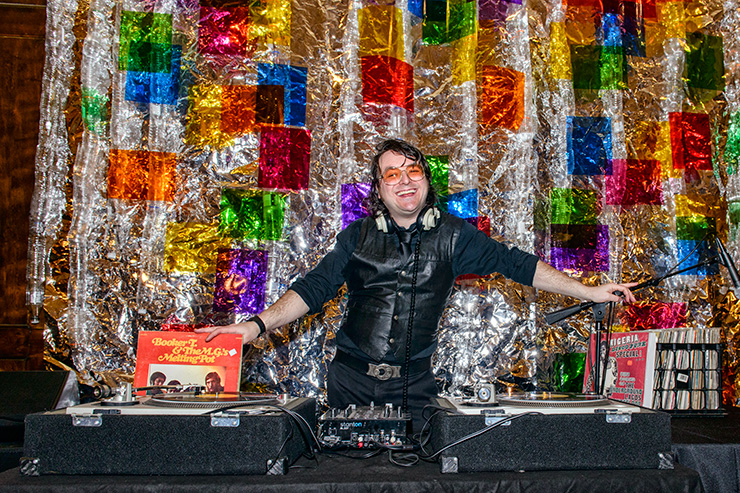
That same energy flowed along with the crowd into the main auditorium as we all took our seats for the first screening of the season, a mix of short films designed to start the festival off with a little bit of everything. Maybe it was the celebratory feel that comes with any opening night or maybe it was the fact that the reception had had an open bar, but the staid, serious atmosphere I'd expected was completely absent. People talked and laughed right up until the show started.
When the first short film ended, the applause was thunderous. When the second film called for the audience to put on those classic, foldable 3D glasses with blue and red lenses, one man shouted “The red goes over the right eye!” and everyone laughed because this was completely wrong and it took half the room a few seconds to realize they’d put their glasses on upside-down. At one point, someone dropped a glass bottle and the entire room listened with barely-contained giggles as the bottle rolled slowly and loudly from the back of the theater’s sloped floor to the front.
The friendly ambiance of opening night left me pleasantly surprised and eager for more, and that eagerness kept me going all the way through Wednesday, which was, if I’m honest, my darkest day at the festival. The first screening I attended that day was News From Home by filmmaker Chantal Akerman and my first feature-length film of the festival. This was a calm, tranquil movie that consisted of lengthy shots of 1970s New York City, as it was when Akerman first moved there from Belgium, with letters from her mother read aloud over (and sometimes under) the bustling street noise.
I went through a few stages of emotion as I watched this film. First I was intrigued, drawn in by the newness of experimental film and fascinated by the idea that these steady, action-less shots could make up an entire movie. Then, I’ll admit, I was bored. I’m a product of the modern age, used to movies laden with special effects and preferably at least one car-chase scene—and I’m used to watching them while I play video games on my phone. So sitting still and watching stillness felt foreign and uncomfortable, sort of like a brand new pair of shoes that I hadn’t quite broken in yet. Then, after a little while, the film seemed to just wash right over me and the steady scenes, the fuzzy crackle of 16mm film, and the quiet tones of Akerman’s soft Belgian accent as she read her mother’s letters became comfortable, almost meditative. Suddenly I was noticing the people in the scenes more, watching their actions and admiring their quintessentially 70s outfits. The moment I stopped resenting the film for not being what I was used to, I could enjoy it for what it was.
Then came the rough patch. My next film screening, which immediately followed News From Home, was another medley of short films, just like the opening night—though this is where all similarities ended. The ten films were all experimental and the entire event was probably my worst-case scenario. I couldn’t grasp the concepts or meanings of any of the films. Some of them contained vaguely familiar imagery cut together in seemingly random order while some seemed like they were intended to be viewed by some alien audience. Some of the films seemed like they were furiously protesting being watched at all. One film was just icons and symbols that flashed bright then dark on the screen to an incredibly loud semi-rhythmic pulsing/pounding noise and by the end it had gotten so aggressive I’d had to plug my ears and close my eyes just to get through it. If ever I have wished for a pair of ruby slippers to click together or a really huge, comedy-sized mallet to clobber myself with, it was then. I left the screening almost afraid to continue on.
But I'd set out to get the full, unadulterated experience of AAFF, and after a night of rest and consideration, I decided that in a festival where there was something for everyone, I was bound to run into some things that weren’t for me.
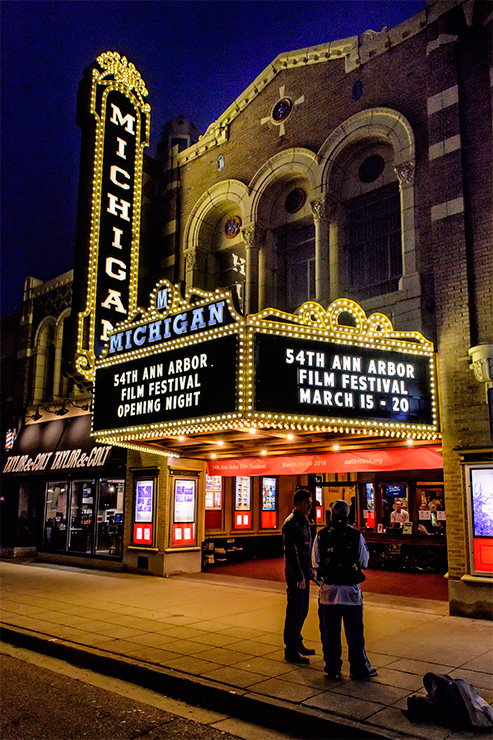
So, like a glutton for punishment, I returned on Thursday for more—and was incredibly glad that I did. The Carl Bogner Juror Presentation was another screening of short films, this time selected by Bogner himself, a lecturer on experimental film at the University of Wisconsin, and my reaction to this event was a complete turnaround from the day before. I left this screening with a satisfied feeling and a number of favorites, including Je Suis Une Bombe (I Am a Bomb), a video of a woman in a panda suit doing a provocative pole dance and then delivering a passionate speech on feminism and womanhood, and My Parents Read Dreams That I’ve Had About Them, which was literally just that—a deadpan elderly couple, presumably the filmmaker's parents, reading dreams about themselves from pieces of paper being handed to them from off screen. The subtle humor of this last film had the entire audience chuckling.
On Friday I returned for my final and longest day of the festival and was immediately faced with something I hadn’t yet experienced—a genuine film festival disaster. As I sat in my first event of the evening, Chantal Akerman’s D’Est, I noticed a few jumps and blips in the steady, slow-moving footage. This film, like her other work, was filled with scenery, people, and little else, this time taking place in East Germany, Poland, and Russia, and as I sat immersed in the quiet images and endless stream of Cossack hats the screen suddenly went dark. I’ll be honest, there had been a few times during the festival where I’d been unable to distinguish experimental films from technical difficulties, so when the screen blinked to life again I was half-convinced this was actually just some zany film technique. What did I know? Then, minutes later, the image on the screen abruptly burst and melted until all that was left was a blank white screen and then darkness. The unified gasp of the audience as the 16mm film burned under the projector was immense, as if the screening room itself had sucked in a breath.
In the past few days, I’d been part of a lot of communal experiences, and now I'd gotten to be a part of a communal tragedy. The sense of loss was a tangible thing in the room and when the screening was ended early (the film, we were told, had experienced some shrinkage and despite his best efforts, there was nothing the projectionist could do to make it usable) all I could do was turn to the person next to me and go, “Oh no, do you think the film’s okay?” like I was asking about a gravely injured friend. Who knew I could feel such deep concern for something that, days before, I’d been glaring at, wishing it had more quippy one-liners and explosions?
My final event, late that night, was also the absolute pinnacle of the festival for me. I'd spent the entire week looking forward to the Animated Films in Competition, or “animation night” as some of the super-hip festival-goers called it. It didn’t disappoint. Even the strangest films were elevated by beautiful animation and almost all featured equally charming stories. Bottom Feeders, by Matt Reynolds, was a terrifying parody of life, death, and reproduction. Love, by Réka Bucsi, was offbeat and whimsical, featuring hugging humanoid fruits and cute but headless horses. And I felt a special love for Nina Gantz's Edmond, about a sweet little man who feels so strongly that he finds himself devouring the things he loves most—especially the people. It was hands-down the most adorable film about cannibalism I’ve ever seen.
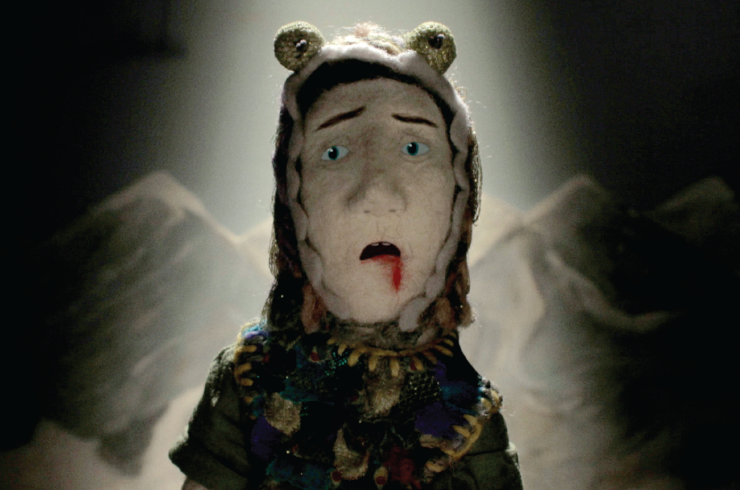
I began AAFF full of worries. Would I like the movies? Would I understand them? Was there anything at all for me at this festival besides, obviously, the many pounds of candy I would inevitably eat?
As it turned out, AAFF took the movie experience I enjoy so much and amplified it to the nth degree. Besides the films themselves, the festival experience was an entirely new beast for me and a remarkably friendly one. Visiting the festival was like being in a popcorn-filled incubator.
After a few days the Michigan Theater, the heart of the festival, began to exert its own gravitational pull and every time I stepped back into the warm lights of the lobby it felt, oddly, like coming home. Each room of the theater became familiar. The backs of peoples’ heads became familiar. “Oh! That’s the hair I saw during yesterday’s film screening,” I would find myself thinking, and then wonder if I was going crazy, and then decide I didn’t care. I became so acquainted with the festival staff and presenters that it was jarring to see them out in the regular world a week later and realize that they didn't know who I was. To them I was just one in a sea of faces, but to me, they were the people who made the announcements and the bad jokes and gave me directions and helped me understand what I was seeing for four days in a row. I grew accustomed to the familiar path from the parking garage to the theater, and from the theater to the neighboring coffee shop, and from the coffee shop to the theater’s screening room. I even sprinted these well-known paths a few (dozen) times when I was nearly (very) late to a screening (or ten).
By the end, AAFF almost had that temporary-home feeling of summer camp, where every face was one I knew and I got to eat as much junk food as I wanted while I wandered around, unfailingly welcome no matter where I was.
Even those films that made me want to pull my hair out and scream seemed to amplify my feelings of success when I found those little theatrical gems that made it all worth it. And besides, when had I ever felt such intense emotion about any movie? Even if it was the all-consuming desire to punch a film right in the face.
It’s tough to say in so few words how I felt about the 54th Ann Arbor Film Festival. It was a strange, funny, boring, exhilarating, fascinating experience. It was a candy-filled, stomach-ache-producing, movie-lover’s-dream experience. It was a fun experience. It was a unique experience.
It was an experience.
Nicole Williams is a Production Librarian at the Ann Arbor District Library and she never thought she'd used the words "adorable" and "cannibalism" in the same sentence. It's been a weird week.
Ann Arbor Film Festival Opening Night
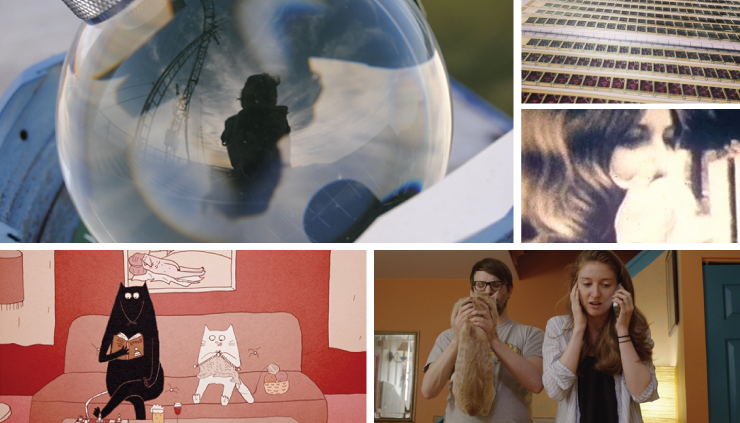
On Tuesday night, the 54th Ann Arbor Film Festival began with an Opening Night Reception and a screening of ten short films from around the world. The reception was a packed and energetic event, completely filling the main lobby of the Michigan Theater with donors, filmmakers, and excited movie-goers. The music was loud, the bites of local food were delicious, and the vast space was packed to the rafters with anticipatory chatter. The total variety of people and apparel gave off the vibe of unadulterated welcome. Some were dressed to the nines in neckties or heels and floor-length dresses, and some were wearing their usual old jeans, sneakers, and plaid shirts, so no matter what, it seemed that this event was made for you.
This was my first experience at AAFF, or a film festival of any sort, and I was a bit apprehensive. Part of my newcomers’ fear was that I’d choose a movie I didn’t enjoy and be stuck with it for the two-hour duration, so it took the pressure off to discover that the Opening Night Screening consisted of a number of short films. The experience was more of a sampler: all the unique flavors of films that you might encounter at AAFF, helpfully squashed into one session.
The films themselves were a mixed bag of narrative, documentary, animated, and experimental, and they ran the emotional gauntlet—from sad and serious, like Hotel 22, a documentary about the homeless taking refuge at night on a 24-hour bus line in San Francisco, to hilarious, like Discontinuity, a film about a couple losing touch with each other and with reality, amongst a sea of disappearing and reappearing cats.
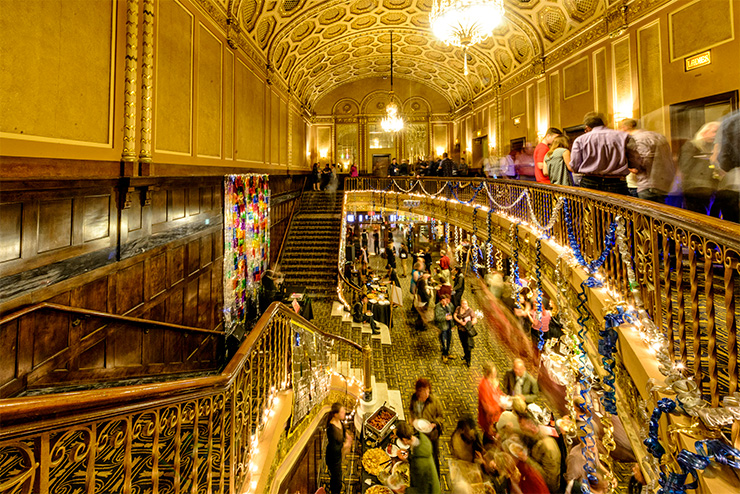
Some films were so experimental that I didn’t even recognize them as films, like REGAL, a fuzzy 2-minute interlude that appeared to be clips of an old pre-movie disclaimer reel interspersed with Internet icons and occasional pauses for buffering. I didn’t realize it was a movie until it was over and my companion clued me in. My first film of the festival and, technically, I missed it.
While some of the films were as avant-garde as I had worried they would be, I found them each to be surprisingly stimulating in their own way. Back Track, a remix of 1950s black-and-white films, had a captivatingly dark, noir vibe. Curt McDowell’s homey A Visit to Indiana effortlessly harnessed the drama and comedy of everyday conversation. Drive In, a close-to-home look at one of the last drive-in theaters in the Detroit area, evoked feelings of sunny summer nostalgia while The Place, a documentary about an isolated weather station, plunged the audience into the cold stillness of a Polish winter. The charmingly untidy animation of Isola del Giglio gave sketch-like impressions of a cozy Sunday morning on an Italian island, while Life with Herman H. Rott told the wordless yet highly comic story of a chain-smoking, drunken rat whose life is tidied up by a neat and proper cat with a love for cleanliness and classical music.
Even when lost among the swirling colors and fuzzy images of an experimental film or staring deep into the impossibly still and dull Polish snowscape, each movie pulled me in and left a genuine impression. I entered the event unsure of what I would find, and when I left, while still unsure what more I would encounter, it was with much more eagerness than apprehension.
Nicole Williams is a Production Librarian at the Ann Arbor District Library and she hates popcorn, so this has been a harrowing experience on many fronts.
Review: Ruta Sepetys on Salt to the Sea

Local young adult author and history fanatic Ruta Sepetys came to Literati on February 10th to discuss her newest work of YA historical fiction, Salt to the Sea.
The book tells the tragic story of teens Joana, Emilia, and Florian, refugees fleeing from Poland and the advance of the Red Army at the end of World War II. Each from a different background and a different country, their paths cross aboard the Wilhelm Gustloff, a real, historic ship that almost no one, including myself, seems to have heard of—despite it being the scene of the worst maritime disaster in world history.
Literati staff opened the evening with a quick introduction of the local author, making sure to mention that her novel Between Shades of Gray was the Ann Arbor/Ypsilanti reads book of 2014. Then Sepetys stepped over to the microphone to introduce herself, her background, and her newest story. Her enthusiasm for writing and storytelling was obvious, but it was clear by the way she lit up as she launched into the Wilhelm Gustloff's tragic tale that she was really in it for the history.
According to her avid research, the Wilhelm Gustloff was a German cruise ship that set sail into the Baltic Sea at the end of World War II packed with thousands of refugees searching for safety. The ship, designed to carry a maximum of 1,400 passengers, was filled with so many fleeing survivors that when it finally set sail, it carried 10,000 passengers, pressed into dining rooms, dance halls, and even the emptied swimming pool. Rooms meant to fit two contained 15 or 20 people. The ship was so heavy, it was forced to sail in deep water—and that's where a Soviet submarine found it and where three well-aimed missiles led to the world’s most fatal maritime tragedy, sinking the ship and sending 9,400 people to the bottom of the Baltic Sea.
Using only a handful of black and white photographs and her undeniable enthusiasm, Sepetys managed to paint a vivid picture of the tragedy and of her research process and keep the crowd completely rapt. With the flair of a master storyteller she managed to pull the audience into the story, hold us in suspense, impress on us the horror of the Gustloff's sinking—and then lighten the heavy atmosphere with a few anecdotes about her search for facts on the ship and its history.
Salt to the Sea was a mammoth effort in research for Sepetys, as she traveled to Poland and several neighboring countries to meet survivors of the disaster, hear stories from men who had dived the wreckage of the Gustloff, and wade through mountains of artifacts and heirlooms from those who lived the tragedy.
Sepetys explained that she chose to tell the story through characters from several different nationalities—Polish, Estonian, Lithuanian, and others—because she had found that the narrative of history could drastically change based on whose cultural experience was being told. You might write a book and think you know what it’s about, she said, but the story is really decided by the reader—and different countries can take one story in some vastly different directions.
She offered up her 2013 novel, Out of the Easy, as an example. Translated into dozens of languages, no two countries seemed to agree on what the book was about. Sepetys, when she wrote it, meant it to be about a girl living amongst the bordellos and brothels of 1950s New Orleans and struggling to shape her own destiny and make a life for herself outside of “The Big Easy.” But in France it’s marketed as a story of feminism in historical context. In Germany it’s a noir thriller. In Poland it’s about decisions and the dynamics that affect choice. And in Thailand, I kid you not, it is called The Hooker Book.
This diversity of interpretations fascinated Sepetys, and gave her a goal for this newest book: to show how the significance of a story could change from person to person, country to country. The author's genuine excitement was infectious and even the Q & A portion of the evening was entertaining as Sepetys enthusiastically answered questions from the audience and listened intently when audience members told their own family refugee stories. It was evident that the stories left the greatest impression on her and she made it clear that telling those stories was Salt to the Sea's main purpose. What exactly affects how history is shaped? Who decides how the stories get told and which stories get told?
Ambitious though it seems, Salt to the Sea works to tell a multitude of those stories within one, tragic story—history, as it is written by the victors and as it is written by the victims.
Salt to the Sea was released on February 2nd.
Nicole Williams is a Production Librarian at the Ann Arbor District Library and if she ever writes a book she is totally calling it The Hooker Book.
Review: You’ll Laugh, You’ll Cry, You’ll Learn Absolutely Nothing: Taylor Mac and His History of Popular Music
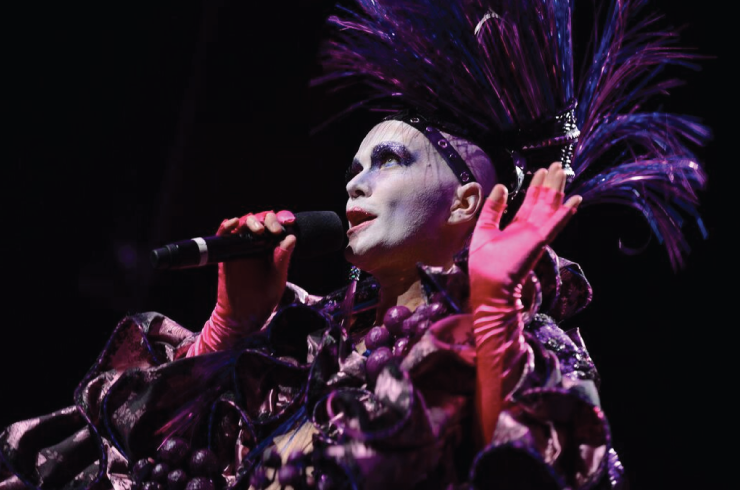
Taylor Mac is not a teacher. If you’re interested in learning history—take a class. Read a book. Get sucked deep into a Wikipedia black hole and hang out for a while.
On Saturday, February 6th, actor, performance artist, and drag queen, Taylor Mac gave a performance of his A 24-Decade History of Popular Music that made me laugh, made me cry, and made me extremely uncomfortable. The only thing it didn’t do was teach me any history. Which, considering just how much it attempted to do—and successfully managed—was not such a big surprise.
Hosted by the University Musical Society, the show was part stand-up routine, part concert, part drag-show, and part performance art. I have no words for this sort of performance amalgamation, and so I was perfectly willing to accept Taylor Mac’s own description of the event as a “radical fairy realness ritual.”
From the start, it was clear that the event would be unusual. Our host, Taylor Mac, came on stage in a hot pink skirt suit spray painted with an American flag on the back, a sash made of soup cans, and a jaunty little hat. Behind him on stage sat a band of seven musicians—a pianist, a bassist, a drummer, a guitarist, a guy who seemed to be playing a different instrument every time I looked at him (saxophone, trumpet, flute, possibly the flugelhorn), and finally, two exceptionally powerful back-up singers.
Mac began the show by explaining the bare bones of his musical project—each hour of the three-hour performance would be dedicated to a different ten-year period: 1956-1966, 1966-1976, and 1976-1986. Each decade came complete with its own costume, eight or nine songs from the time, and a central historic theme. This performance was just a fraction of a much larger endeavor Mac has planned for a later date, a 24-hour performance with an hour for every decade from America’s inception in 1776 all the way up to the glorious pop-fest that is the year 2016. Mac explained the idea that he would be on stage for a full 24 hours, singing and entertaining non-stop without food, bathroom, or sleep breaks, with the casual air of someone who is either very confident or incredibly irresponsible. Possibly both.
Probably both.
The first decade of our less-ambitious 3-hour show, ’56-’66, focused on aspects of the Civil Rights movement, or, as Mac puts it, “Songs Popular in the Bayard Rustin Planning Room.”
It kicked off with a slow and sultry rendition of Jay Hawkins’s “I Put A Spell On You.” By itself this would have been excellent entertainment—Mac’s stellar flair for theatrics is matched by his smooth, powerful voice. But just in case the audience had started to settle into the comfortable idea that they were at some tedious concert-meets-comedy-meets-drag-show, Mac introduced a new and terrifying element: audience participation.
After a very brief introduction of the racially tense atmosphere pervading the late ‘50s, Mac asked all of the straight, white people in the audience to stand up and slow-motion run to the sides of the room, simulating white flight.
“I understand that there won’t be a lot of room for you over there,” Mac said to the amazingly willing audience as they wiggled and stepped over each other to get to the sides of the room, “But I really want you to get the feel of the suburbs. I want you to be so close together that there’s a straight, white person on top of you even when you really don’t want a straight, white person on top of you.”
By the end of the song, I wasn’t sure if I was laughing, crying, or hyperventilating. If you’ve never seen a hundred people of all ages, including senior citizens, slow-motion run to the sides of a room and pack in like sardines, I highly recommend it.
With all of the elements fully introduced, the show really got under way. The ‘56-‘66 hour contained a bit of background on race issues and centered its attention on the March on Washington, though unfortunately most of the story that Mac told focused on the imagery of getting on a bus to go to the March. It involved an awful lot of audience playacting of getting to the bus/being on a bus/singing on a bus, without much actual information on the March itself.
Despite the fact that Mac didn’t tell much of a story, the music certainly did. The songs were well-chosen, a combination of Civil Rights anthems like The Staple Singers’ “Freedom Highway” and Nina Simone’s “Mississippi Goddam” and chart-toppers like The Supremes’ “You Keep Me Hangin' On” and Bob Dylan’s “A Hard Rain’s a-Gonna Fall.” The songs that came with their own clear message, such as the impossible-to-misinterpret “Mississippi Goddam” were as powerful as you might expect. But even the popular hits, thrown in front of the backdrop of the 1950s and forced into context gave songs like Simone’s “Don’t Let Me Be Misunderstood” deeper meaning and even greater muscle.
I’ll admit it—the ‘56-‘66 decade was definitely my jam. But the following decades carried the same sort of structure and a lot of the same impressive weight.

Curtis Mayfield’s "Move On Up" transitioned us into the 1966-1976 decade, as Mac stripped down to a tiny yellow Speedo on stage, then disappeared behind the curtain and remerged in an outfit made up of so many different things that I honestly couldn’t tell if it was a dress, a jumpsuit, or if he’d tripped and fallen into a scrap box on his way back to center stage. The whole ensemble was tied together by a rainbow cape made of clear plastic tubes and a glittery silver headdress. This era had its eye trained on the beginnings of the gay liberation movement and the Stonewall riots of 1969. Songs included Bruce Springsteen’s “Born to Run,” Patti Smith's "Birdland," and The Rolling Stones' "Gimme Shelter."
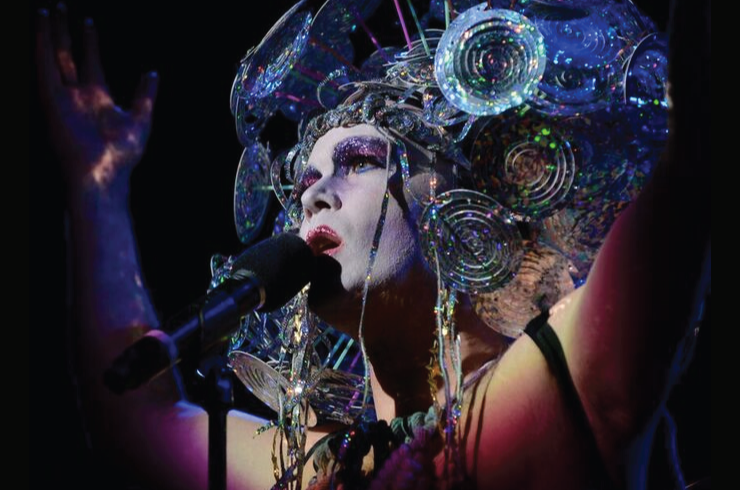
The 1976-1986 decade focused on the idea of the '70s and '80s club scene and their infamous "back rooms." This aspect of history seemed like an odd choice until I realized that these "back rooms " were a prevalent part of Mac's own experience as he came up in the club scene. Dressed in a bright silver jumpsuit with a ruffled purple shawl and a shiny purple mohawk, Mac told his most personal (and most graphic) stories during this era in between Laura Branigan's "Gloria," David Bowie's "Heroes," and Prince's "Purple Rain."
The gaps between each song were filled with comic stories, musings, and, of course, the obligatory ridiculous activities that come with performance art. During the 1956-1966 portion of the show, audience members were asked to dance, march, engage in some pretty exaggerated crying, and, finally, to email Rick Snyder.
Sometime around the 1970s, we were handed ping-pong balls to throw at Mac as he ran through the aisles in his rainbow-tube cape and yellow Speedo. As we moved into the late '70s part of the show, Mac pulled an older gentleman up on stage and sang him a love ballad, while the pianist groped the man’s leg.
In the '80s, he had an entire row of the upper balcony come downstairs, go behind the curtain onstage, and emerge in ridiculous wigs, boas, and glasses and dance through the aisles. Each activity was a bit more unbelievable than the last, finally culminating in a college-aged boy standing patiently still while Taylor Mac kissed him and rubbed glitter lipstick all over his face. Permission was not asked, just a perfunctory, “You’re over 18, right?”
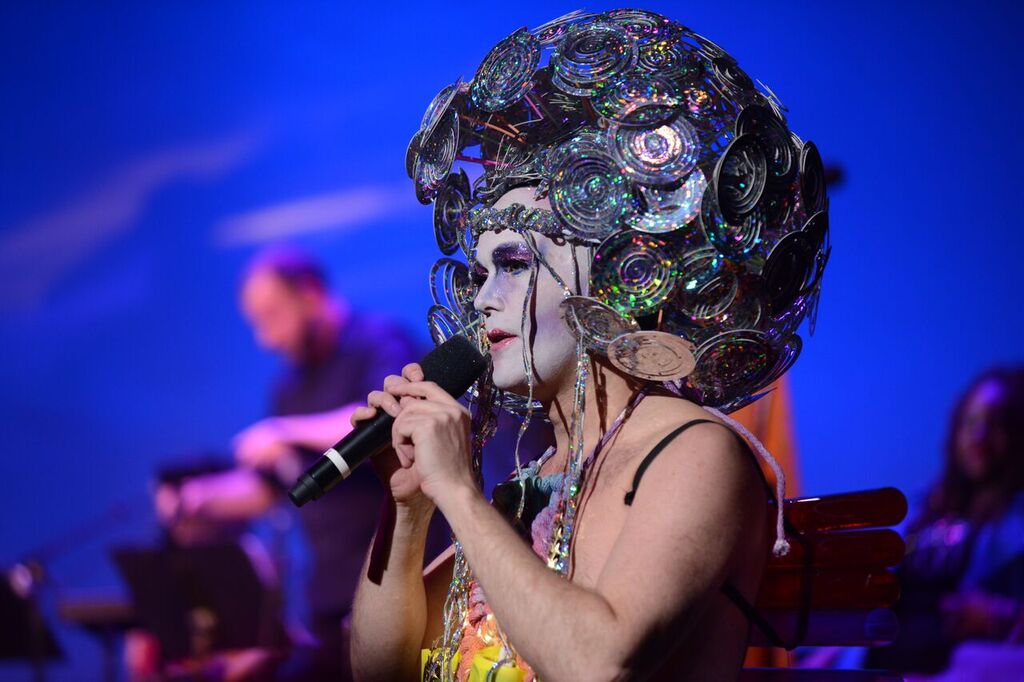
It was wonderfully weird, and, while the entire thing carried the feel of a glittery game of Russian roulette as we waited to see who would be Mac’s next participation victim, it also succeeded in doing exactly what Mac had told us it would—creating a shared experience for the audience. The audience was incredibly good-natured, dancing when asked, moving when asked, and making sure to applaud loudly and sincerely for anyone who was a good enough sport to obey instructions like, “go stand on stage, but don’t smile and don’t dance” or “lay down on the floor and let these five strangers carry you out of the room.”
From all this highly entertaining madness, I only came away with one critique. As a person who would have loved all the elements of this show even if they were completely separate and not one giant, Katamari Damacy-style ball-of-everything, I was absolutely enchanted by this performance, so much so that I didn’t even resent Mac for keeping me up past my 8 pm bedtime. Give me comedy, music, or drag any time of day and I’m game. But I was also interested in the promise of some really good history-nerd satisfaction, and so I was a bit let down by the minimal emphasis on the actual history.
While Mac did occasionally address the lack of historical fact—“If you want to know more about the March [on Washington…Google it. What about this outfit says anything more than Wikipedia?”—I felt like it was such a shame to dismiss the history so casually because of how much it could have brought to the show. Even the barest skeleton of historical facts would have ramped up the storytelling element and could have made this fun and flighty show a little bit stronger and a lot more engrossing, particularly in the gaps between musical numbers.
But considering how much it did do right, I really can’t fault it for the one thing it didn’t completely ace. The show managed to be a masterful musical performance, an entertaining drag show, and a surprisingly fun communal audience experience, so really, who cares if he didn't include a history lesson? It was still a performance I’m not likely to forget. At least, not in this decade.
Nicole Williams is a Production Librarian at the Ann Arbor District Library and, despite this positive experience, still thinks audience participation is the worst.
Local Woman Sees Star Wars: The Force Awakens

Two weeks ago, the long-awaited Star Wars movie, The Force Awakens, hit theaters like a ton of space-bricks. Hordes of people of all different ages, all kinds of backgrounds, and varying levels of nerdiness flooded theaters on December 17th to see what this latest installment had to offer. They showed up to theaters two hours before the movie. They stood in lines that stretched out the door, around the corner, and possibly into the street. They ate popcorn by the bucketful and shouted over each other to answer the theater staff’s trivia questions and win free movie tickets (most likely for return trips to see this exact same movie). And, lucky me, I was one of the many, standing in line at 9 pm with my ticket in hand, waiting for the theater doors to open. There was really only one thing separating me from the eager crowd of fans humming with excitement around me:
I had never in my life seen a Star Wars movie.
I know. Suddenly my “space-bricks” comment makes a lot more sense, doesn’t it? I know exactly zero things about Star Wars, so for all I know space-bricks are totally relevant to this fandom.
I am fully aware that every person in the world has seen Star Wars. I’m pretty sure they screen it for newborn babies in the maternity wards at hospitals. It’s been around for almost 40 years, but somehow I had managed to stumble through life without ever seeing it. I never accidentally watched one while at a friend's house or in a waiting room or settled on one while flipping through channels—you know, back in 2008 when people still had cable.
So when the new movie came out, and friends invited me along, I decided, “Yeah, ok. That could work. How important is it REALLY to have seen the other movies? I mean, I know stuff about Star Wars.”
This line of thinking was pure folly. A group of Star Wars-loving co-workers showed me just how wrong I was with an informal, pre-movie interview. Here are the things I “knew” about Star Wars before seeing the movie - spoilers ahead, but only for people as Star Wars-sheltered as me:
[begin embarrassing transcript]
So, what are you pretty sure you already know about Star Wars?
Luke and Darth Vader are related.
They sometimes fly around in ships and shoot at things, like giant desert rats.
One of the planets is, like, a desert planet.
Han Solo shot first. The internet was pretty adamant about that one.
Yoda talks funny and is green and small and…him and Luke were buds?
Jar Jar Binks is a gold robot. No, wait, he's the guy with the weird face!
There's a scene where there's deserts! Or planets.
Ok, what do you know about the general plot of Star Wars? Give us a summary.
Luke Skywalker is the Chosen One of some kind. He lives on a planet that is not Earth and fights some dudes. Not really sure about his motivation. He hangs out with Yoda and Han Solo and they teach him how to use a lightsaber. He goes to fight Darth Vader because no one likes that guy. They go to the Death Star, which is round and has a dent in it. Darth Vader wants to kill him for... reasons? Then there are storm troopers and they wear white and there are other kinds of storm troopers that look similar but are different. And they fight them? And they win? And Darth Vader dies? But first he says "Luke, I am your father." And that's all I know.
Who is Jabba the Hutt?
He's a fat guy who has Leia in a gold bikini. I know that because of Friends. Wait, is that guy blue?
What do you know about Boba Fett?
I don't remember. Is he an alien? He's not a person. Not as crazy looking as Jar Jar Binks. Is he a robot?
What about Obi-Wan Kenobi?
I used to think Harrison Ford was Obi-Wan Kenobi. But actually, he's Han Solo. I just assume they are both Harrison Ford.
How do you think the ewoks enter into this?
Oh. Yeah. Is Chewbacca an ewok? They are some sort of space animal…that are either Chewbacca or…I'm imagining them smaller? Like the footstool in Beauty and the Beast. You know that little dog?
Who is Anakin Skywalker?
That one I know! That guy is Darth Vader. He was a nice guy once and then his face got jacked up. So under his mask he has a jacked up face. What's his motivation? What's that guy up to? Is he trying to take over the universe? People are always trying to do that.
Who's the Emperor?
Is that different than Darth Vader?
Who is Lando Calrissian?
He is from across the Narrow Sea and has dragons and wants the Iron Throne?
Who does Natalie Portman play?
She was Princess Leia, right?
No.
Really!? Wow. I was like 80% sure she was Princess Leia.
What is the Force?
It's like chi? Energy. You use it for... fighting? With lightsabers? You should use it. I know you use it. And also that sometimes it is with you. Can it be good or bad? I think it's good.
What's a Jedi?
Oh, a Jedi is like an auror in Harry Potter. They fight crime and stuff and they wear brown robes. Also like Harry Potter! Wait, lightsaber color is important. I don't know why I know that. Do they have different powers? Do people have powers in this movie? Um, I know Jedis can return. They went somewhere and came back. Is Jedi plural? I think it's a job.
[end embarrassing transcript]
Yup. So, clearly I was starting on a solid foundation of very correct facts. I’m pretty sure by the end of the conversation, I was just directly quoting from movie titles. I am still not totally sure how wrong my information was, but I could kind of gauge it by how horrified my co-workers looked after each answer.
And so, armed with all of this very factual knowledge, I went to see the seventh Star Wars movie. I waited in line for two hours with a horde of die-hard Star Wars fans wearing quippy t-shirts. Some were dressed up as That One Character Who Wears Gray, or That Person With the Brown Clothes, or Princess Leia (nailed it). And lots of them were toting around what I thought at the time was some kind of zany orange and white space-hat (but was apparently a robot called BB-8). I watched my Star Wars-obsessed friends answer trivia questions and yell at a guy who dared to wear a shirt with a Star Trek font. I ate two pretzels.
And then it was finally time for the movie. We flooded into the theater, the lights went out, and the magic began.
Considering that I barely knew who anyone was or what was going on, the movie kept me completely hooked from beginning to end--aside from a very brief couple of seconds when I fell asleep because, well, it was almost midnight and I was basically full of pretzel cheese.
I thought the movie was funny, exciting, and incredibly realistic for a space opera. Spaceship chases? Yes, please! Lightsaber fights? Bring 'em on! But there were also real feelings, real relationships, and real stakes in this movie. Who'd have thought?
The main characters were just impossible not to root for. Finn, the stormtrooper who's been trained to kill for the dark side, but decides run off and fight for the Resistance; Rey, the clever, solitary junkyard girl who accidentally gets swept into this epic battle between good and evil; and BB-8, the world's most adorable space-hat, who is being hunted by the Republic.
Now, I'm not sure if a stormtrooper turning his back on the dark side and running away to fight for good is something that has ever happened in the Star Wars universe. If I'm honest, before Finn pulled off his helmet in the movie I didn't even realize stormtroopers were people. If I'm really, really honest, I didn't even know stormtrooper was one word. But the revelation that stormtroopers could have feelings and weren't all just soulless killing robots felt like a pretty new and exciting leap in character development to me--and a pretty cool introduction to the universe. All my preconceived notions, few though they were, were just blown to bits and suddenly it felt like anything could happen. If stormtroopers could be good maybe C-3PO would pull off his face to reveal that he's the Emperor. The possibilities were endless!
Rey was a joy to watch as she went from impoverished junkyard scavenger to lightsaber-wielding, butt-kicking fighter for the Resistance, and her chemistry and banter with Han Solo was so much fun. Kylo Ren, with his motivations and backstory left intentionally foggy, managed to seem well-rounded, and the relationships that were hinted at gave his character some great depth. As far as I can tell, Star Wars isn't known for making two-dimensional villains, and they certainly haven't started with Kylo Ren.
These allusions to histories and relationships between the movie's characters felt like completely new revelations, not old references that I just wasn't getting. But it was interesting how easy it was to pick up on the things that were old inside jokes. I didn't get any of them, of course, but I could tell when some classic Star Wars thing had happened because suddenly the camera would pan around to a nondescript, decrepit spaceship and everyone would start screaming and cheering. Or Han Solo would stop and say something completely unremarkable and the entire theater would explode into laughter and applause.
The combination of old references and new information made something incredibly clear, though. While I could probably say that Star Wars: The Force Awakens was a good movie--I enjoyed seeing it and only fell asleep the one time--it would be impossible for me to say just how good it was without having seen the other beloved (and less-beloved) films in the series. Are these ideas, these characters, these plot lines original and revolutionary and surprising, or are they overdone tropes? Are they carefully planned and well-thought-out tie-ins to plot lines from the previous movies or have they kicked the old plot lines to the curb? Is this the continuation of one great big, epic story or an entirely new story with some familiar faces tacked on?
On a great big list of "Things I Don't Know About Star Wars," these questions have all risen to the top. Right below the biggest question of all: Was Star Wars: The Force Awakens really a good movie?
I think so. But I can't know for sure until I've seen the rest. And so, with the next movie in the franchise looming on the horizon, it might be time to give in to the gravitational pull of the Star Wars universe and just…watch the movies already.
Nicole Williams is a Production Librarian at the Ann Arbor District Library and if she had to rename The Force Awakens, she would call it Star Wars: Stormtroopers Have Feelings Too. Or maybe, Star Wars: Everyone In Space Has Daddy Issues.
Star Wars: The Force Awakens is in theaters everywhere, all the time.
The Other Kind of "Pop" Music: A2SO's Holiday Pops

On December 11th the Ann Arbor Symphony Orchestra celebrated the Christmas season with their 4th annual Holiday Pops performance. Combining music, song, and some audience-provided sound effects, the show captured all the best things about the holidays: cheer, togetherness, and good music.
I went in expecting the good music, so I wasn’t surprised when they started with some classic wintery waltzes, ballet pieces, and a host of other refined orchestral numbers that made me feel like I should have worn fancier clothes. It was beautiful and stirring and, after getting over the amazing sight of the instruments at work, I listened to most of it with my eyes closed. But I was pleasantly surprised a few songs in when the show revealed itself for what it really was—pure holiday ridiculousness in a fancy suit.
The conductor took a break from his straight-laced conducting for some charming holiday banter, ironically reminding the audience to go out and play in the snow and to see the heart-warming holiday film “Krampus.” Then he and the orchestra launched into a second wave of pieces that were just as beautiful, but far jollier. One song that perfectly combined the feeling of sophisticated symphony with festive silliness was the “Champagne Gallop,” an upbeat piece that included regular pauses for an exuberant “pop!” sound, mimicking the popping of a champagne cork. Technically, this sound was supposed to be made by the percussion section—but what fun would that be? Instead, the conductor asked the audience to create the popping sound themselves with the trusty finger-in-the-mouth trick. Suddenly, a song that would have been a pretty good time all by itself was made even better by the hilarious sound of 500 audience members making popping noises every time the conductor waved his hand in our direction. It was, in a way, like being a part of the orchestra—if there was a section of the orchestra designated to ridiculous sounds you can make with your mouth.
But generally speaking, there is not. I checked.
Partway through the program, the orchestra opened its doors and ushered in a flood of choirs: the Boychoir of Ann Arbor, Measure for Measure, the Skyline High School Choir, the Ann Arbor Youth Chorale, and the Greenhills Choir. The orchestra’s performance was made all the more buoyant by the addition of song as each choir took its turn and, finally, joined the audience for a good, old-fashioned holiday sing-along. As the evening ended with the audience belting out verses of "Jingle Bells," "O Christmas Tree," and "We Wish You a Merry Christmas," the performance went through one last transformation, taking on the feel of a fun and cozy family get-together—complete with cheerful, off-key singing in my ear and children kicking the back of my seat.
Ah, Christmas.
Nicole Williams is a Production Librarian and she actually has no idea how to make that finger-in-the-mouth popping sound.
The Ann Arbor Symphony Orchestra's next big event will be their Mozart Birthday Bash at the Michigan Theatre on January 16th. Tickets are available online from their website.


































